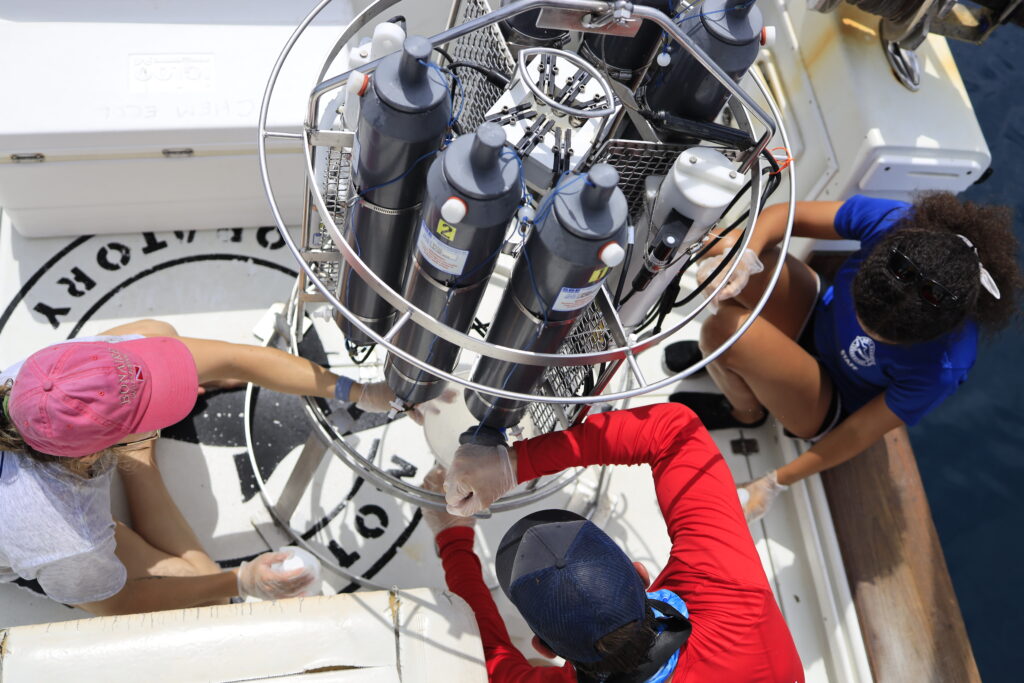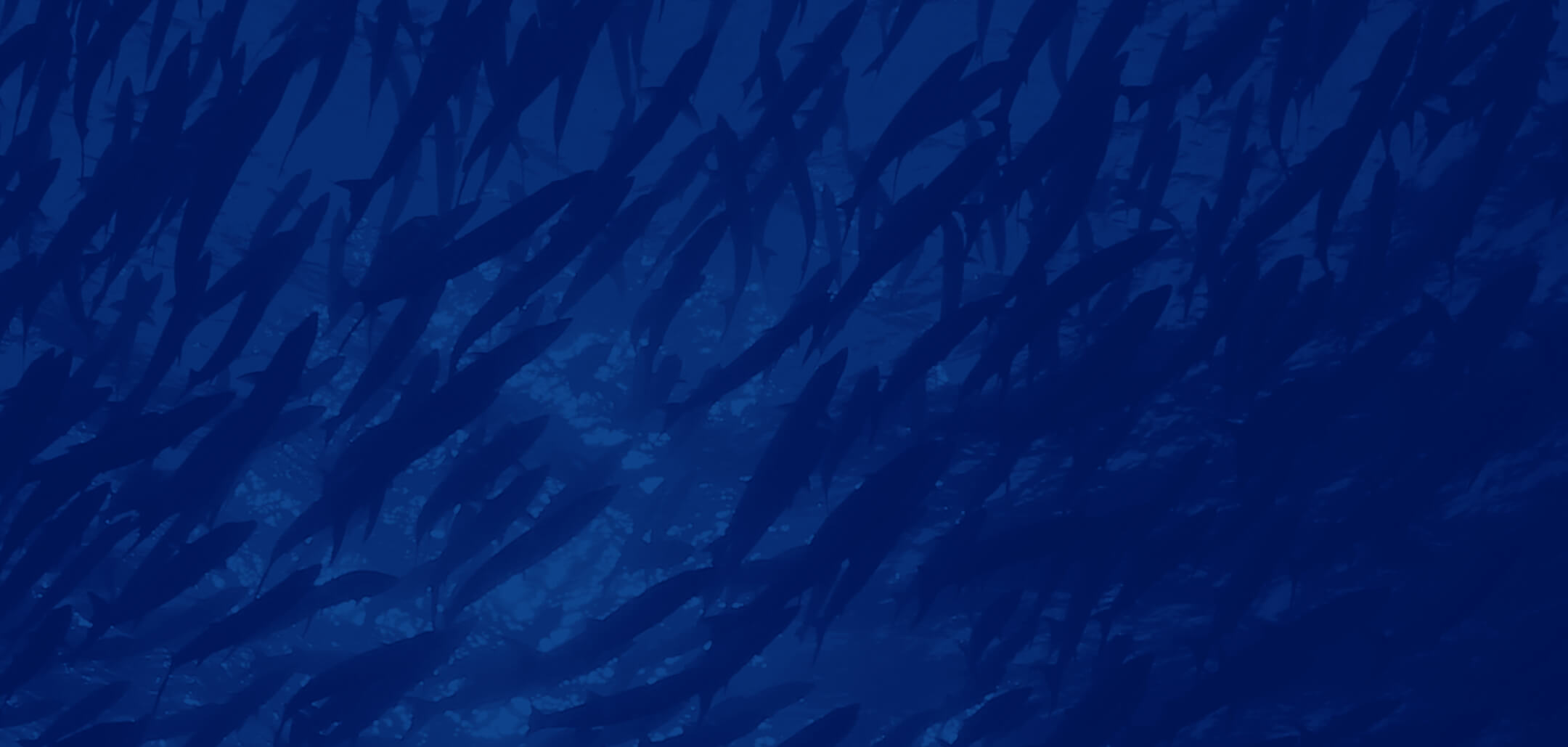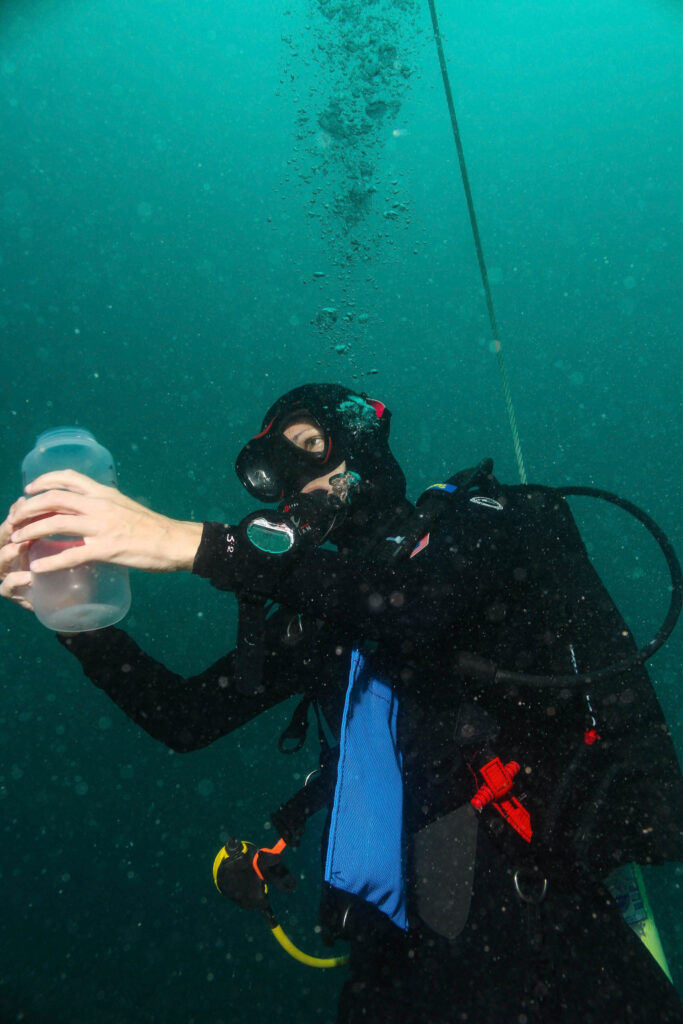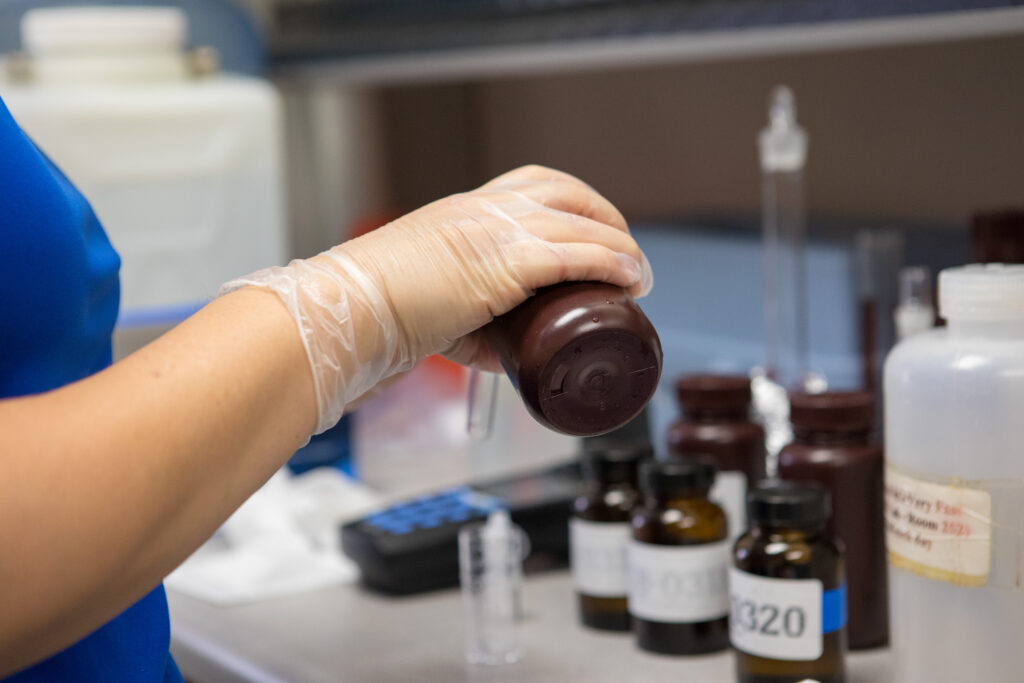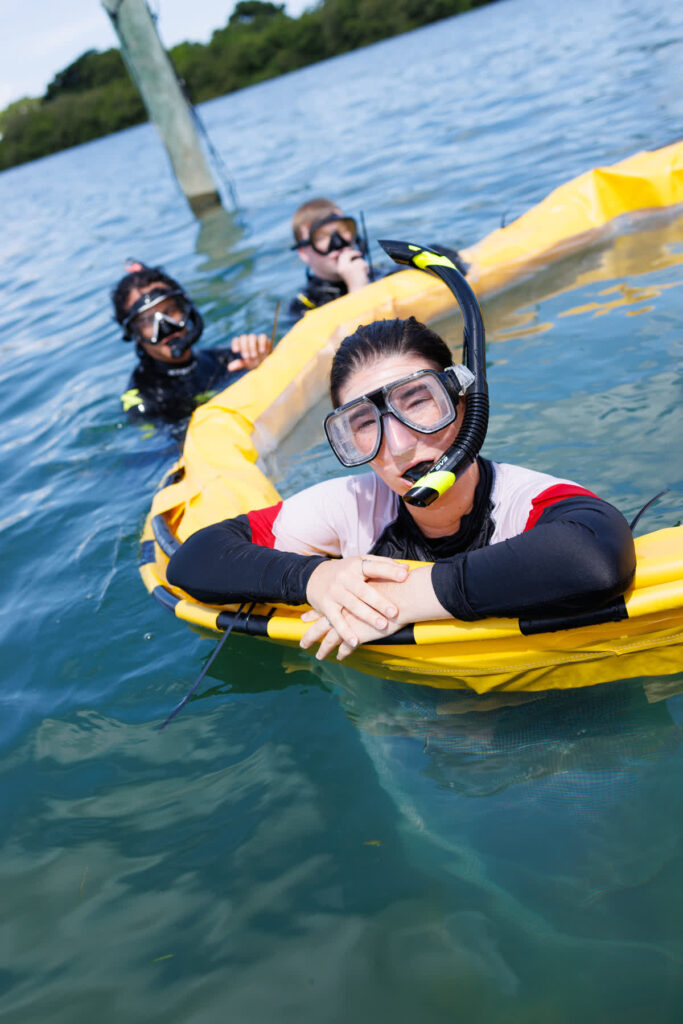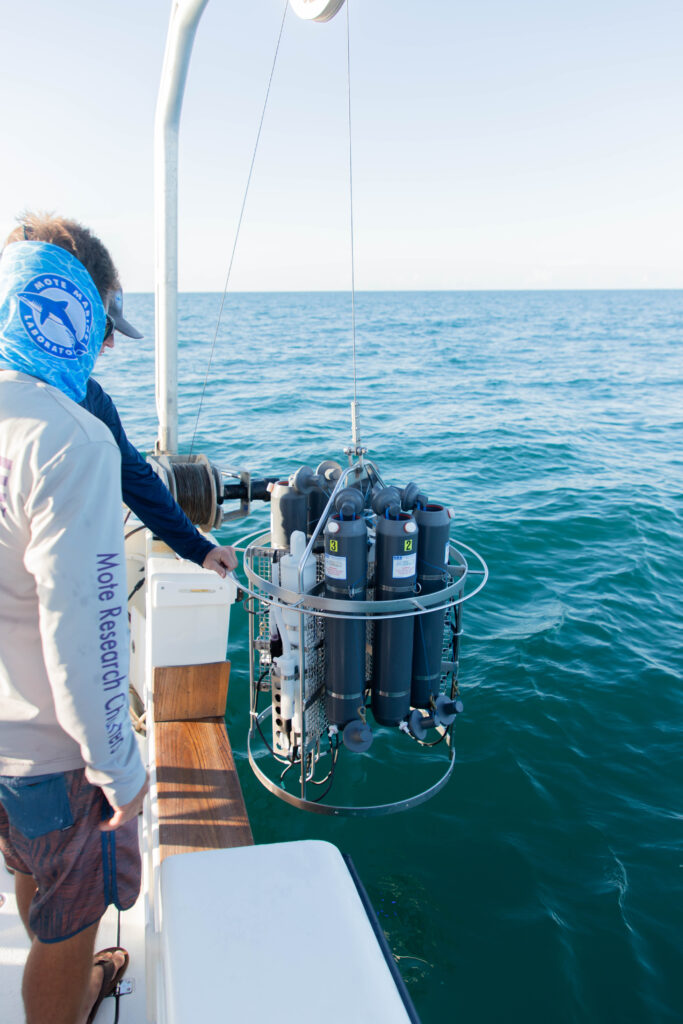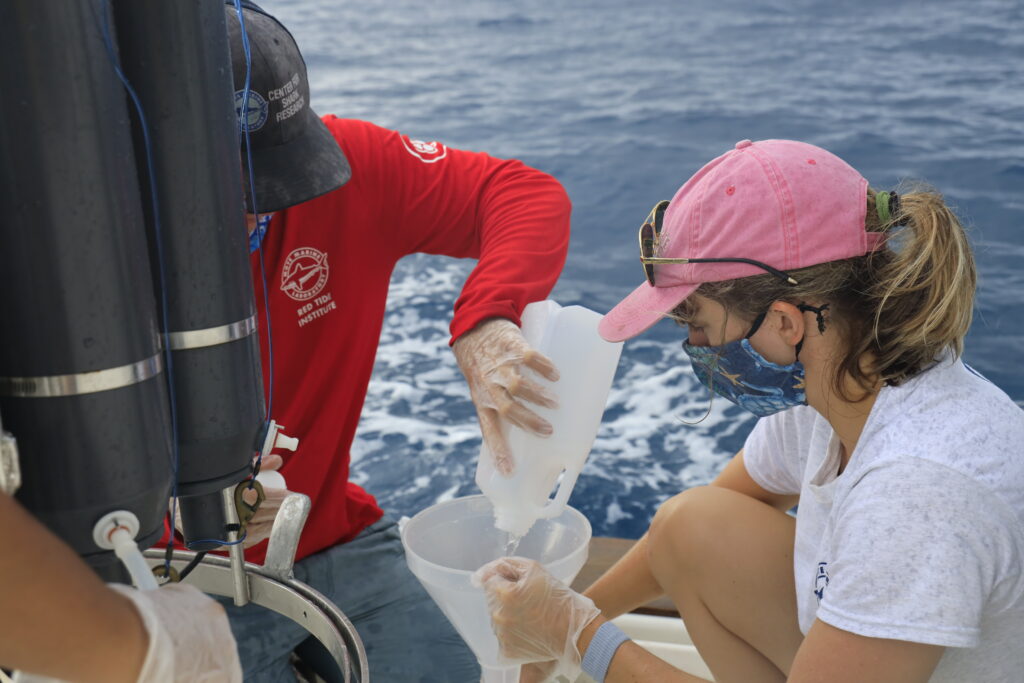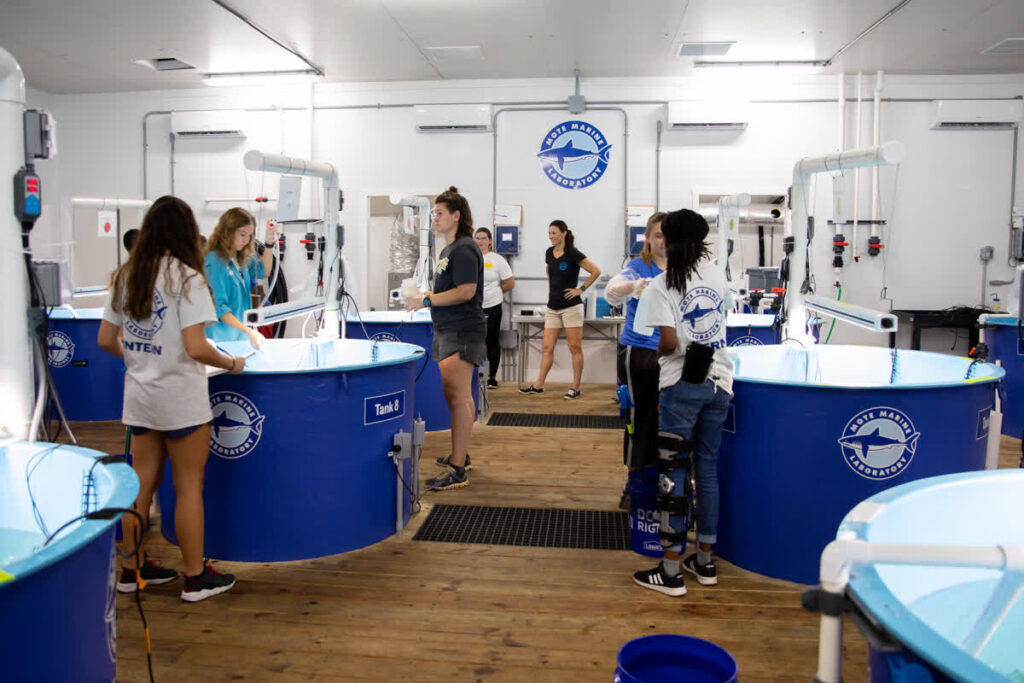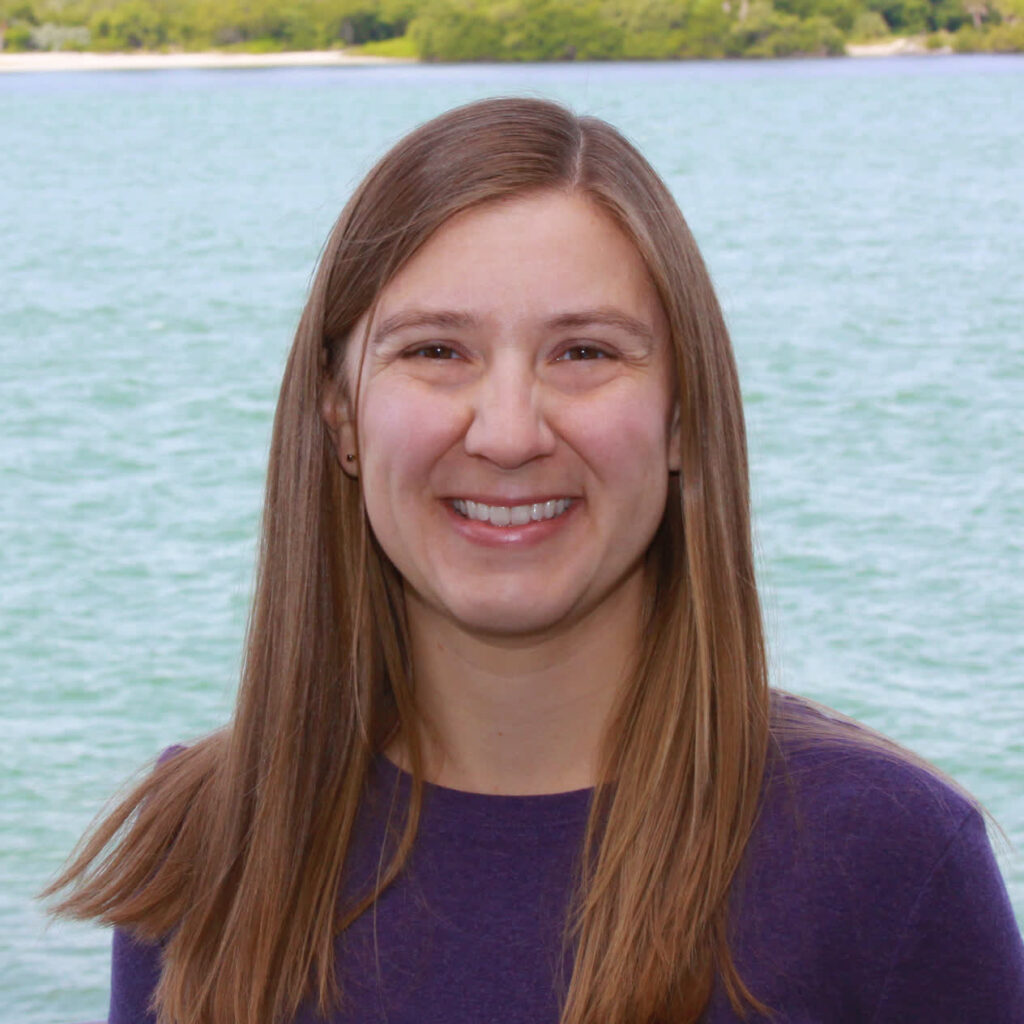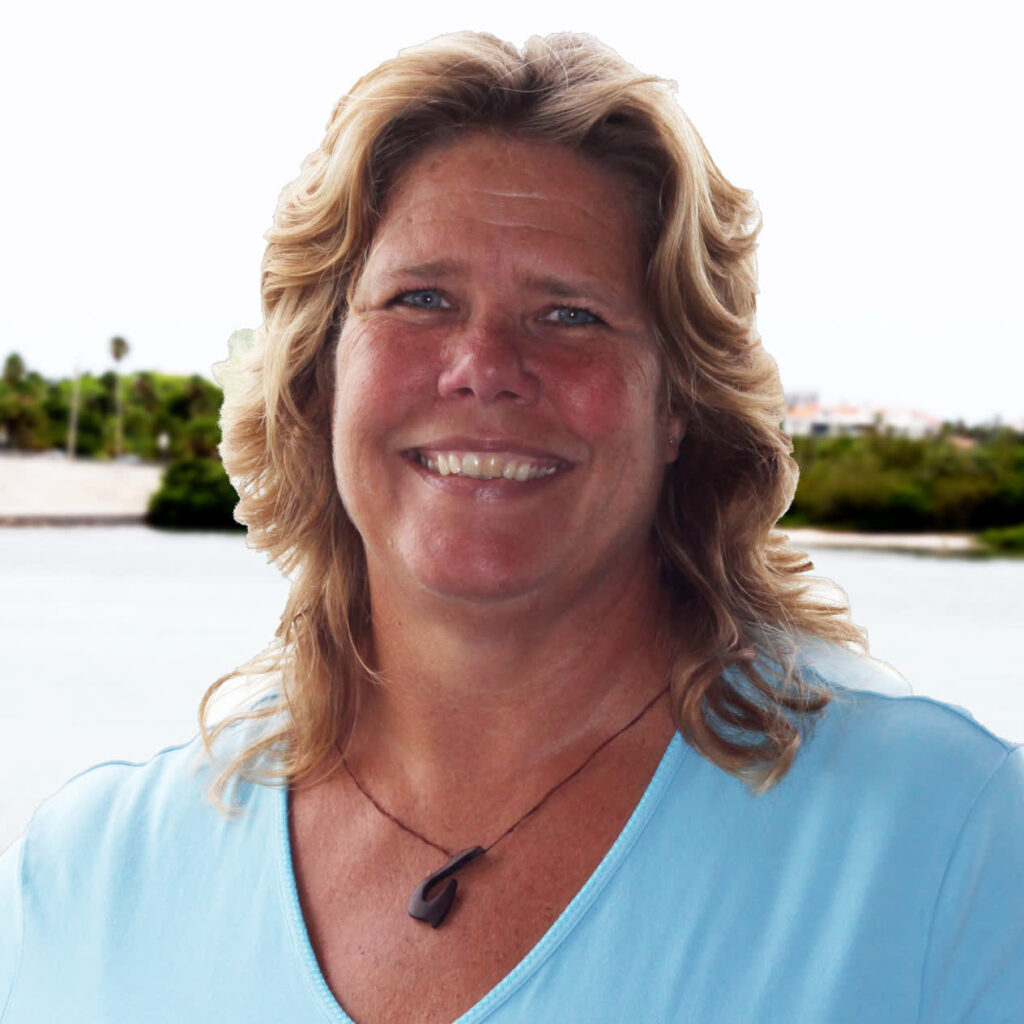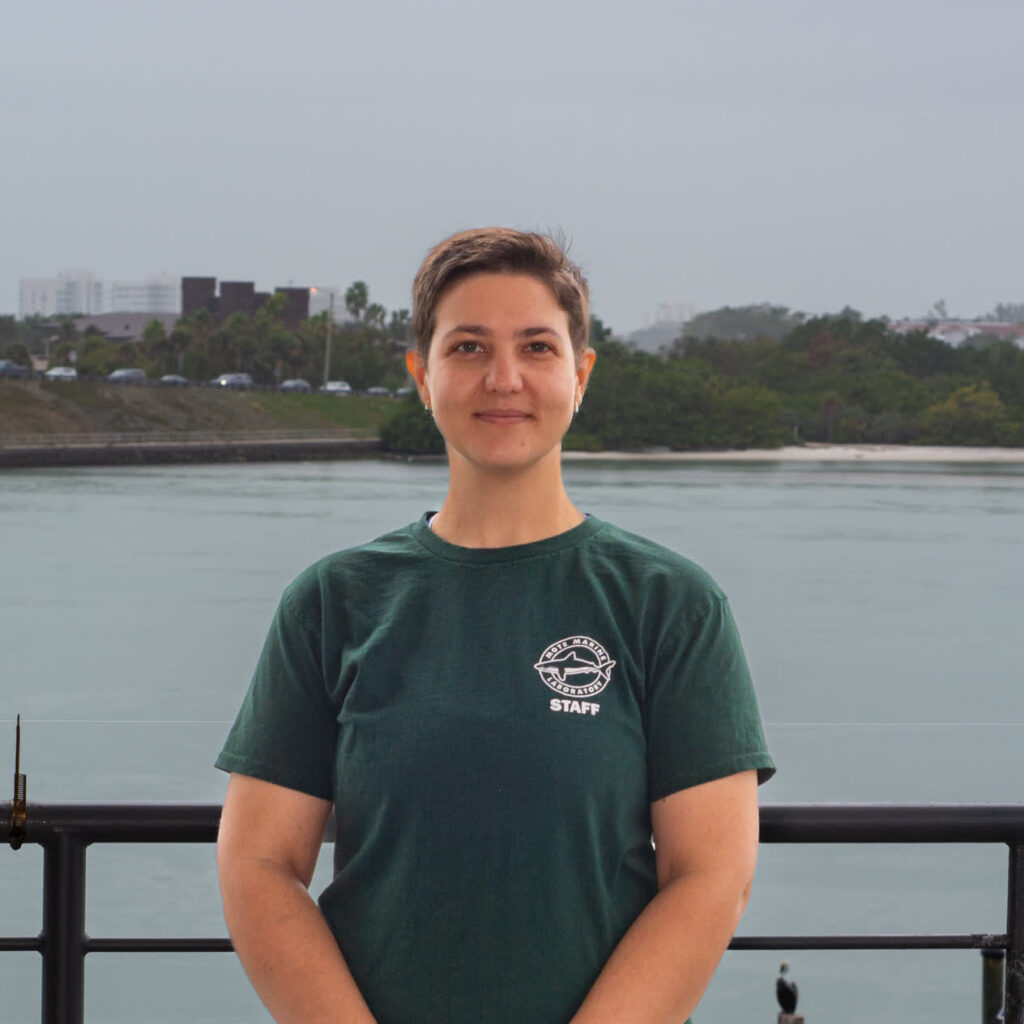The Chemical & Physical Ecology Program addresses both research and applied science questions on the impacts and interactions of nutrients (nitrogen, phosphorus, and silica) and physical parameters (salinity, light) in riverine, estuarine and coastal environments. The group forms a NELAC-approved water quality laboratory with certification inspections conducted by the Florida Department of Health and a Quality Manual which addresses all aspects of sample collection, analytical and reporting practices. These quality measures are applied to all projects to ensure acceptable accuracy and precision of all analytical results.
Areas of focus for the program include statistical analyses of the nutrient regimes associated with blooms of Florida’s “Red Tide,” Karenia brevis, as well as other phytoplankton taxa. We are examining the variations in the supply of nutrients from the major SW Florida estuaries, and are also studying the responses of both typical coastal phytoplankton and K. brevis to selected nutrient additions under more controlled laboratory experiments. Novel sources of nutrients that may support harmful algal blooms have also been examined, quantifying either the amount of nutrients supplied as flux from the sediments to the water column or measuring the nutrient concentrations of sediment interstitial waters.
Freshwater supplies to estuaries are under considerable pressure as Florida’s population and drinking water demands increase. The Program has performed a number of studies to establish the chemical and physical conditions of tidal rivers as a function of flow rates to allow Florida’s Water Management Agencies to set appropriate withdrawal limits that are protective of estuarine biota and habitats. We also continue to provide monitoring services to permitted entities to ensure that these limits remain effective and appropriate and to permit municipalities to track the conditions and trends of their respective estuarine waters. Projects include both routine discrete sampling at selected stations, intensive surveys with flow through instrumentation and water quality measurements, stormwater sampling and installations of continuous monitors of weather, water level and water quality.
Funding agencies have included the U.S. EPA, NOAA, the State of Florida, Southwest and South Florida Water Management Districts, Tampa Bay Estuary Program, Sarasota Bay Estuary Program, Charlotte Harbor National Estuary Program, Florida Department of Environmental Regulation, Florida Department of Health, as well as local counties and cities.
Program Details
- Unprecedented Hurricane Ian Nutrient and Organic Matter Inputs to Southwest Florida Coastal Waters
- Nitrogen chemistry in marine sediment and connection to Karenia brevis blooms
- Deployment of a nitrate sensor – WIZ – in Sarasota Bay
- Ambient water quality monitoring of Sarasota Bay
- Lake Guard Dew Efficacy Towards Nutrient and Harmful Algal Bloom Reduction
- Myakkahatchee Creek Hydrobiological Monitoring Program
- Water quality monitoring program for the City of North Port
- Red Tide Mitigation Projects
- Storm Pulse Events
- FWRI-Mote Cooperative Red Tide Monitoring and Research Program
- Anthony Janicki – JEI
- Barbara Kirkpatrick – Mote
- Brett Cunningham – Jones Edmunds
- Charles Kovach – FDEP
- Chris Anastaciou – SWFWMD
- Cynthia Heil – Bigelow
- Dave Tomasko – Atkins Global, Inc.
- Debbie Bronk – Virginia Institute of Marine Science
- Ernest Estevez – Mote
- Gabriel Vargo – University of South Florida
- Gary Hitchcock – University of Miami
- Gary J. Kirkpatrick – Mote
- James Fitzpatrick – HDR, Inc.
- Jason Lenes – USF
- Jay Leverone – SBEP
- John J. Walsh – USF
- Judith O’Neil – University of Maryland
- Karen Steidinger – FFWCC-FWRI
- Ken Leber – Mote
- Kevan Main – Mote
- Margie Mulholland – Old Dominion University
- Mark Alderson – SBEP
- MerriBeth Neely – FDEP
- Michael S. Flannery – SWFWMD
- Mike Wessel – JEI
- Paula Coble – University of South Florida
- Philip Murphy – HydrO2
- Ralph Montgomery – Atkins Global, Inc.
- Ray Pribble – JEI
- Richard Pierce – Mote
- Roger Johannson – JEI
- Steve Peene – ATM, Inc.
Proud Partners in the Red Tide Initiative
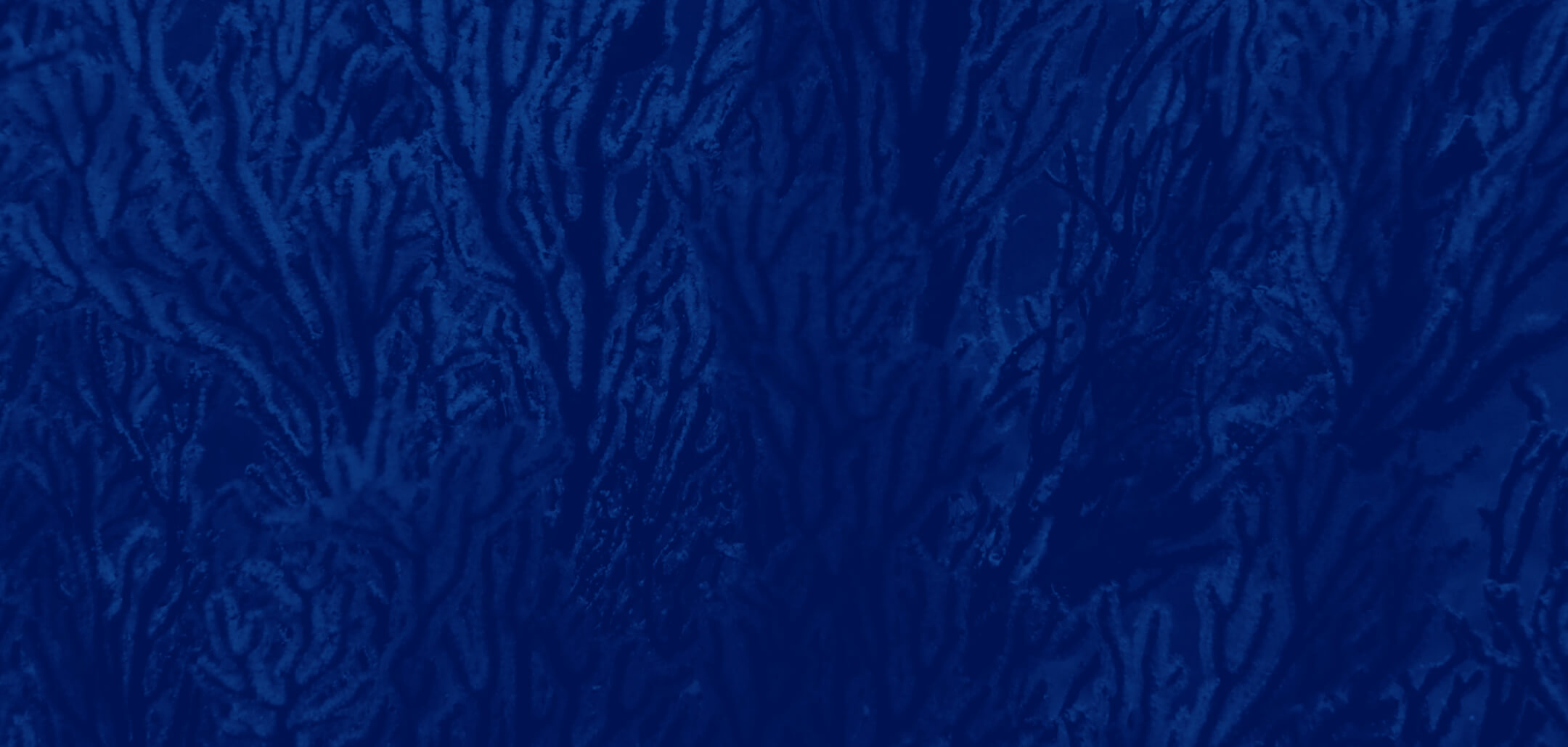
Additional Program Information
- 2024 Hall, E.R., Heil, C.A., Frankle, J.D., Klass, S., Devillier, V., Lovko, V., Toyoda, J.H., Pierce, R. Mitigation of Karenia brevis cells and brevetoxins using curcumin, a natural supplement. Water 16, 1458. https://doi.org/10.3390/w16101458
- 2024 Dilworth J, Million WC, Ruggeri M, Hall ER, Dungan AM, Muller EM, Kenkel CD. Synergistic response to climate stressors in coral is associated with genotypic variation in baseline expression. Proc. R. Soc. B 291: 20232447. https://doi.org/10.1098/rspb.2023.2447
- 2024 Devillier, V.M., Hall, E.R., Lovko, V., Pierce, R., Anderson, D.M., Lewis, K.A. Mesocosm study of PAC-modified clay effects on Karenia brevis cells and toxins, chemical dynamics, and benthic invertebrate physiology. Harmful Algae, 134: 102609. https://doi.org/10.1016/j.hal.2024.102609
- 2024 Klepac, C.N., Petrik, C.G., Karabelas, E., Owens, J., Hall, E.R. and Muller, E.M., Assessing acute thermal assays as a rapid screening tool for coral restoration. Scientific Reports, 14(1): 1898.
- 2024 Hall, E.R., Yates, K.K., Hubbard, K.A., Garrett, M.J., Frankle, J.D. Nutrient and carbonate chemistry patterns associated with Karenia brevis blooms in three West Florida Shelf estuaries 2020-2023. Frontiers in Marine Science, 11:1331285. doi: 10.3389/fmars.2024.1331285.
- 2023 Hall, E.R., Dixon, L.K., Kirkpatrick, G.J., A. Nissanka, B.A. Pederson. Phytoplankton communities of the west coast of Florida – multiyear and seasonal responses to nutrient enrichment. Harmful Algae, 130: 102547.
- 2023 Devillier, V.M., Hall, E.R., Anderson, D.M., Lewis, K.A. Exposure of blue crab (Callinectes sapidus) to modified clay treatment of Karenia brevis as a bloom control strategy. Harmful Algae, 128: 102492.
- 2023 Wessel, M.R., Beck, M.W., Sherwood, E.T., Peebles, E.B., Hall, E. Establishing a community of practice for tidal creek research using conceptual models and open science. Florida Scientist, 86(2): 362-369.
- 2023 Culter, J.K., Hall, E.R., Byrd, G., Cole, C. Diving techniques for exploration of submarine karst features of the west Florida continental shelf. Diving for Science 2023: Proceedings of the American Academy of Underwater Sciences 40th Symposium. Verde, E.A. & Scott-Ireton, D.A., eds. pp. 5-17.
- 2023 Klepac C.N., Eaton K.R., Petrik C.G., Arick L.N., Hall E.R., Muller E.M. Symbiont composition and coral genotype determines massive coral species performance under end-of-century climate scenarios. Front. Mar. Sci. 10:1026426. doi: 10.3389/fmars.2023.10264262022
- 2022 Mallon, J., Cyronak, T., Hall, E.R., Banaszak, A.T., Exton, D.A., Bass, A.M. Light-driven dynamics between calcification and production in functionally diverse coral reef calcifiers. Limnology and Oceanography 9999:1-16. doi: 10.1002/lno.12002
- 2022 Osborne, E., X. Hu, E.R. Hall, K. Yates, J. Vreeland-Dawson, K. Shamberger, L. Barbero, J.M. Hernandez-Ayon, F.A. Gomez, T. Hicks, Y.Y. Xu, M.R. McCutcheon, M. AAcquafredda, C. Chapa-Balcorta, O. Norzagaray, D. Pierrot, A. Munoz-Caravaca, K.L. Dobson, N. Williams, N. Rabaliais, P. Dash. Ocean acidification in the Gulf of Mexico: Drivers, impacts, and unknowns. Progress in Oceanography, p.102882 https://doi.org/10.1016/j.pocean.2022.102882
- 2022 Glibert, P.M., W.J. Cai, E.R. Hall, M. Li, K.L. Main, K.A. Rose, J.M. Testa, N.K. Vidyarathna. Stressing over the Complexities of Multiple Stressors in Marine and Estuarine Systems. Ocean-Land-Atmosphere Research, 2022.
- 2022 Burnham, K.A., Nowicki, R.J., Hall, E.R., Pi, J. and Page, H.N. Effects of ocean acidification on the performance and interaction of fleshy macroalgae and a grazing sea urchin. Journal of Experimental Marine Biology and Ecology, 547, p.151662.
- Muller EM, Dungan AM, Million WC, Eaton KR, Petrik C, Bartels E, Hall ER, Kenkel CD. Heritable variation and lack of tradeoffs suggest adaptive capacity in Acropora cervicornis despite negative synergism under climate change scenarios. Proc. R. Soc. B 288: 20210923. https://doi.org/10.1098/rspb.2021.0923
- 2021 Page, HN, C Hewett, H Tompkins, and ER Hall. Ocean acidification and direct interactions affect coral, macroalga, and sponge growth in the Florida Keys. J. Mar. Sci. Eng. 9, 739. https://doi.org/10.3390/jmse9070739
- 2021 Patin, NV, ZA Dietrich, A Stancil, M Quinan, JS Beckler, ER Hall, J Culter, CG Smith, M Teillefert, and FJ Sewart. Gulf of Mexico blue hole harbors high levels of novel microbial lineages. The ISME Journal, https://doi.org/10.1038/s41396-021-00917-x.
- 2020 Hall, E.R., L. Wickes, L.E. Burnett, G.I. Scott, D. Hernandez, K.K. Yates, L. Barbero, J.J. Reimer, M. Baalousha, J. Mintz, W.-J. Cai, J.K. Craig, M.R. DeVoe, W.S. Fisher, T.K. Hathaway, E.B. Jewett, Z. Johnson, P. Keener, R.S. Mordecai, S. Noakes, C. Phillips, P.A. Sandifer, A. Schnetzer, J. Styron. Acidification in the U.S. Southeast: causes, potential consequences and the role of the Southeast Ocean and Coastal Acidification Network. Frontiers in Marine Science, 7:548. doi: 10.3389/fmars.2020.00548
- 2018 Hall, E.R., E.M. Muller, T. Goulet, J. Bellworthy, K.B. Ritchie, and M. Fine. 2018. Eutrophication may compromise the resilience of the Red Sea coral Stylophora pistillata to global change. Marine Pollution Bulletin 131:701-711.
- 2017 Muller, E.M., N.M. Leporacci, K.J. Macartney, A.G. Shea, R.E. Crane, E.R. Hall, and K.B. Ritchie. Low pH reduces the virulence of black band disease on Orbicella faveolata. PLoS ONE, 12(6): e0178869.
- 2016 Banc-Prandi G., K. Imhof, E. Hall, and K. Ritchie. Interspecific coral bacterial competition under ocean acidification scenarios. Proceedings from the 13th International Coral Reef Symposium, Honolulu: 58-70.
- Perault, J.R., Muller, E.M, Hall, E.R., Rotjan, R.D. Presence of the northern star coral (Astrangia oculata) as an epibiont on the carapace of a nesting loggerhead turtle (Caretta caretta) in the western Gulf of Mexico, USA. Reef Encounters 31(1):46.
- 2015 Hall, E.R., B. DeGroot, and M. Fine. Lesion recovery of two scleractinian corals under low pH conditions: implications for restoration efforts. Marine Pollution Bulletin, 100:321-326.
- 2014 L.K. Dixon, G.J. Kirkpatrick, E.R. Hall, and A. Nissanka. Nitrogen, phosphorus and silica on the West Florida Shelf: Patterns and relationships with Karenia spp. occurrence. Harmful Algae 38:8-19. http://dx.doi.org/10.1016/j.hal.2014.07.001
- 2014 Heil, C., L.K. Dixon, J. Lenes, M. Garrett, E. Hall, L. Killberg-Thorsen, D. Bronk, K. Meyer, B. Walsh, J. O Neil, L. Procise, M. Mulholland, G. Hitchcock, G. Kirkpatrick, R. Weisberg, and J.J. Walsh. Nutrients, management and Karenia blooms: sources, sinks and cycling of nutrients to Karenia brevis blooms in the eastern Gulf of Mexico. Harmful Algae, 38:127-140. http://dx.doi.org/10.1016/j.hal.2014.07.016
- 2012 Hall, E.R., D. Vaughan, and M.P. Crosby. Development of ocean acidification flow thru experimental raceway units (OAFTERU). Proceedings from the 12th International Coral Reef Symposium, Cairns, Australia.
- 2012 Hall, E.R., K. Nierenberg, A.J. Boyes, C.A. Heil, L.J. Flewelling, and B. Kirkpatrick. The art of red tide science. Harmful Algae 17:1-5.
- 2006 Hall, E.R., Booth, M.M., Delfino, J.J. Sedimentary organic matter in the Alafia and Little Manatee Rivers in West-Central Florida. Florida Scientist 60:224-235.

